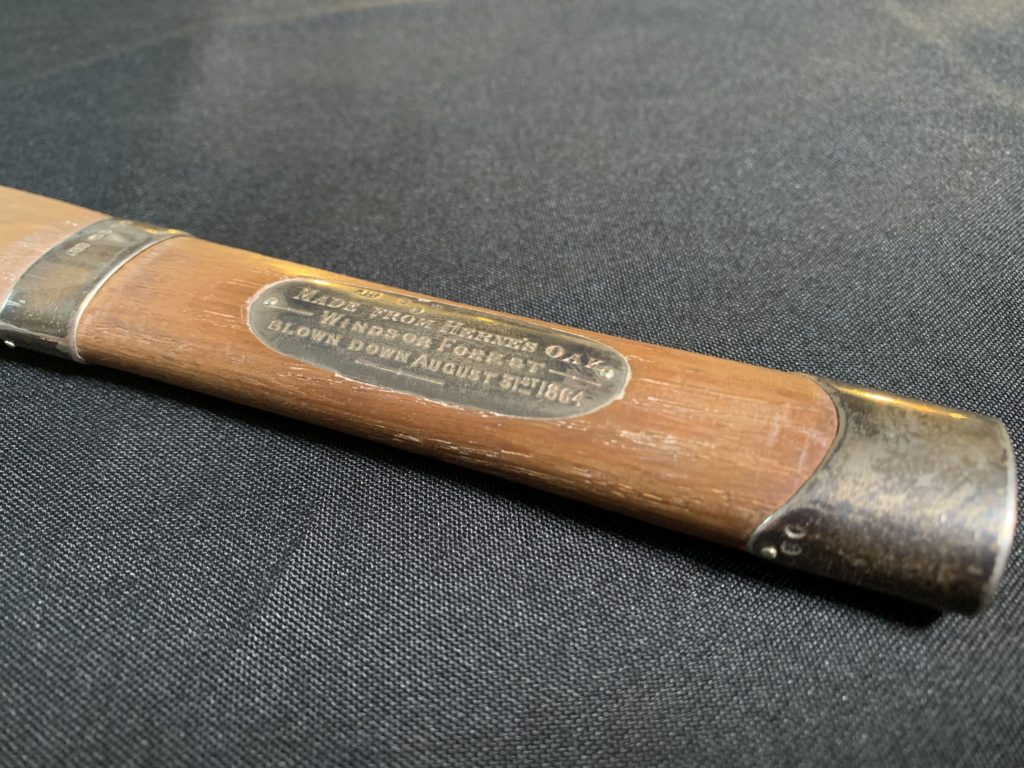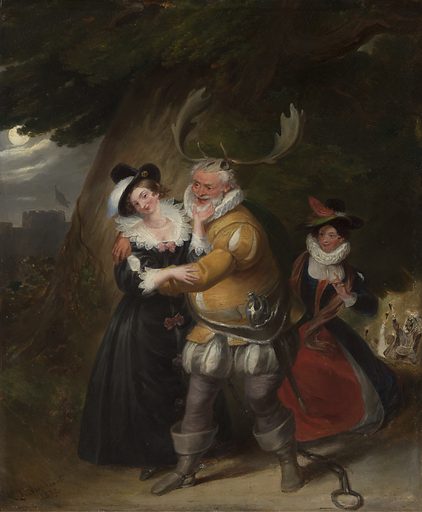Herne’s Oak Paper Knife



This paper knife is associated with the Schröder family, who resided at the Manor House at Dell Park, Englefield Green. They were a prominent family in the area and several family members are buried at St Jude’s Churchyard, Englefield Green. A paper knife is used to open letters in a smooth manner, in order to avoid tearing the envelope or letter.
The paper knife itself is made from the wood of ‘Herne’s Oak’, a tree that was once located in Windsor Great Park and was famous for its mention in Shakespeare’s ‘The Merry Wives of Windsor’. The mythic figure of ‘Herne the Hunter’ is an ancient legend particular to the area of Windsor and is also mentioned in the play.

There is an old tale goes that Herne the hunter,
Sometime a keeper here in Windsor forest,
Doth all the winter-time, at still midnight,
Walk round about an oak, with great ragg’d horns;
And there he blasts the tree and takes the cattle
And makes milch-kine yield blood and shakes a chain
In a most hideous and dreadful manner:
You have heard of such a spirit, and well you know
The superstitious idle-headed eld
Received and did deliver to our age
This tale of Herne the hunter for a truth.
William Shakespeare, ‘The Merry Wives of Windsor’, Act IV, Scene 4
However, there does seem to have been some serious debate regarding the authenticity of the tree itself, and if the tree blown down in 1863 was indeed the original one mentioned in ‘The Merry Wives Of Windsor’, as an earlier tree was seen as a possible candidate.
Unfortunately, this tree was cut down accidentally in 1796 on orders of King George III. This debate must have been quite serious, as even Queen Victoria waded into the debate and allowed the publication of ‘A Treatise On The Identity of Herne’s Oak’, which supported the claim that the tree of 1863 was in fact the real Herne’s Oak. This was written by William Perry, who was the official ‘Wood Carver’ for Queen Victoria. Perry was also given pieces of tree to carve into souvenirs as the tree was the property of the crown. A photograph of this tree, taken before it was blown down, is seen on the front cover of the publication.
Interestingly, the paper knife gives the date of 31st August 1864, which does not match to the day that the oak was blown down, given as 31st August 1863.
It is possible that this knife might not be made from Herne’s Oak as it was stated in the Illustrated News on the 24th of September 1863 that ‘the desire to possess portions of this relic, made famous in Shakespeare’s “Merry Wives of Windsor” was so great that a guard had to placed over it night and day in order to prevent it being carries off in fragments’. This coupled with the incorrect date undermines the authenticity of this object. Even if it had been carved by William Perry, it is unlikely that he would have given an incorrect date. Furthermore, how the paper knife came to be left in the possession of the Schröders is also an interesting, yet sadly unknown story. The Schröder’s were an elite family originally from Hamburg, now part of Germany. They were granted the right to the continued use of the honorific ‘Baron’ and ‘Baroness’ while residing in Great Britain as a result of this. The first of the Schröder dynasty to reside in Englefield Green was John Henry William Schröder, who was born in 1825. John Henry William Schröder settled in England in 1864, the same year that is stated on the knife, and continued to run his family’s bank. This firm still exists as ‘Schroeder’s PLC’ and now functions as an asset management company.

The house seems to predate the Schröder family, as there is a record of an Archibald Campbell Douglas Hawkesley residing there in 1863. Unfortunately, Hawkesley ended up before the Court of Bankruptcy in 1863 after incurring serious debt. He seems to be a wealthy individual, and therefore sold his house to pay his debts, possibly to the Schröders. Baron John Henry William Schröder died without children in 1910.
Bruno Schröder (this may be Baron John Henry William Schröder’s nephew, but it is unclear) purchased ‘Heath Lodge’(now the Savill Court Hotel) in 1910. However, directories before 1910 still list a Schröder residing at ‘The Dell’. It is possible that Baron Bruno Schröder bought Heath Lodge as a second property in the area. His daughter, Marga Schröder, resided at ‘The Dell’ estate until her death in 1977, and the house was sold in 1980.
Her sister, Helene Dorothee Eveline Emma Schröder grew up at ‘The Dell’ and lived locally to Egham for her entire life. She was involved in many local societies, including the Egham-by-Runnymede historical society. The knife was donated by her.
Katie Smith
More about the Schröders: https://eghammuseum.org/the-schroder-family-of-englefield-green/


